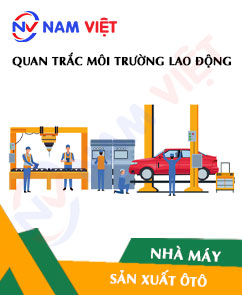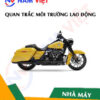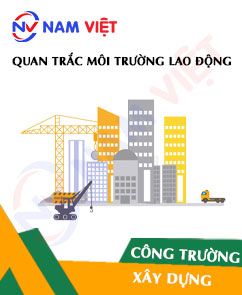Occupational environment monitoring of an automobile manufacturing factory
99,000 ₫
Note: The above price is calculated for one sample, and the price may fluctuate depending on the area of the environment to be monitored and market movements. For more accurate pricing support, please refer to the price list or contact our consulting staff directly.
Monitoring the environment of a automobile manufacturing factory is a session of collecting, analyzing, and evaluating factors at the workplace that may harm workers health.
Table of Contents
Toggle1. Overview of the automobile manufacturing factory
a. What is an automobile manufacturing factory?
Factory for automobile manufacturing is an industrial facility designed and equipped to produce various types of automobiles. It organizes production processes from initial design, machining and assembly of parts, to final finishing and quality control.
Automobile manufacturing factories are usually large, divided into workshops and specialized areas for different production stages.

b. Production stages in an automobile manufacturing factory
Production stages in an automobile manufacturing factory include:
- Design and development: This includes market research, detailed design, simulation, and testing. Automotive engineers and designers use CAD/CAM software to create 3D models of automobiles and verify feasibility.
- Part machining: Automobile parts, including the chassis, engine, transmission, suspension, brakes, electrical system, interior, etc., are machined in dedicated workshops. Machining involves cutting, welding, stamping, molding, precision machining using CNC machines, and other processes.
- Chassis assembly: Chassis components are assembled and welded to form the basic structure of the vehicle. This includes assembling the chassis, floor, engine bay, and other components.
- Electrical system assembly: The electrical system, including wiring harnesses, dashboards, lighting, audio, air conditioning systems, etc., is installed and connected to the chassis.
- Basic system assembly: Other systems such as suspension, brakes, steering, fuel system, cooling system, etc., are assembled and connected to the chassis.
- Interior assembly: Interior components, including seats, dashboards, entertainment systems, temperature control systems, etc., are installed into the chassis.
- Testing and adjustments: Testing and adjustment stages ensure the quality and performance of the automobile. Systems and components are inspected, adjusted, and function-tested before final finishing.

c. Machinery used in automobile manufacturing factories
Common machinery used in automobile manufacturing factories includes:
- Mechanical machining machines: Including milling machines, lathes, grinders, drills, CNC lathes, CNC mills, and other CNC machines. These are used to machine metal components in automobile manufacturing.
- Welding machines: Including MIG/MAG welders, electrode welders, laser welders, and spot welders. Used to assemble and weld vehicle parts and chassis.
- Press and casting machines: Including plastic presses, mold presses, and metal casting machines. Used to produce plastic and metal parts for automobiles.
- Cutting and precision machining machines: Including plasma cutters, laser cutters, water jet cutters, CNC precision machines. Used for cutting and precise machining of metal components.
- Packaging and assembly machines: Including automatic packaging machines, automatic screw machines, and assembly line machines. Used to assemble parts and components into vehicles.
- Inspection and measurement machines: Including 3D measuring machines, durability testers, brake testers, engine testers. Used to check quality and performance of parts and vehicles.
- Industrial robots: Used in assembly, welding, painting, and inspection processes. Improve efficiency and precision.
- Painting machines: Including automatic paint machines, electrostatic powder coating systems, high-temperature oil painting systems. Used to paint and finish vehicle surfaces.

d. Occupational diseases that may occur for workers in automobile manufacturing factories
Workers in automobile manufacturing factories may suffer from some occupational diseases related to their work and environment, including:
- Respiratory diseases: Exposure to metal dust, chemicals, fumes, and irritants can lead to pneumonia, bronchitis, sinusitis, and other respiratory problems.
- Skin diseases: Exposure to chemicals, oils, cleaning solutions, and detergents can cause skin irritation and conditions like dermatitis, eczema, and burns.
- Spine and musculoskeletal disorders: Lifting heavy objects, working in incorrect postures, and repetitive movements can cause spine and joint problems, including degenerative spine and joint diseases, back pain, and carpal tunnel syndrome.
- Hearing disorders: High noise levels from machinery and work processes can lead to hearing loss, deafness, or noise-related conditions.
- Hand and neck disorders: Repetitive tool use and movements may cause functional disorders like hand tremor or wrist strain.
- Chemical-related diseases: Exposure to chemical compounds during manufacturing may lead to occupational diseases.

e. Types of products in automobile manufacturing factories
Main products include:
- Automobiles: Personal cars, sports cars, multi-purpose vehicles, trucks, buses.
- Automobile components: Engines, air conditioning systems, suspension systems, brake systems, steering, transmissions, and other parts.
- Spare parts: Tires, batteries, headlights, carburetors, wipers, cooling systems, etc.
- Test vehicles: Used for research, testing, and evaluating new car models.
- Electric and hybrid vehicles: Vehicles using clean, eco-friendly energy sources.

2. Overview of occupational environment monitoring services
a. What is occupational environment monitoring in automobile manufacturing factories?
Occupational environment monitoring (or workplace environment measurement) in automobile manufacturing factories involves collecting, evaluating, and analyzing metrics of workplace environmental factors to implement timely measures, minimize health hazards for workers, and prevent occupational diseases. Monitoring is legally required for all automobile manufacturing factories.
It plays a critical role in protecting and improving workers’ health, as labor is the main resource directly generating profit. Continuous exposure to excessive hazards can affect health and cause occupational diseases.
REGISTER OCCUPATIONAL ENVIRONMENT MONITORING SERVICE
b. An Toan Nam Viet’s occupational environment monitoring program
An Toan Nam Viet’s program is researched by monitoring engineers in occupational safety and environmental protection. Using modern measurement methods, it monitors air, water, microclimate, physical, and dust factors in the workplace. It ensures a safe working environment and protects workers’ health.
The program also helps research and develop new solutions to improve workplace environment quality. With a dedicated and professional monitoring team, An Toan Nam Viet’s proprietary program is a breakthrough in occupational safety and environmental management in Vietnam.

c. Standardization in occupational environment measurement procedures
Standardization in An Toan Nam Viet’s occupational environment measurement procedures is a crucial aspect to ensure the quality of measurement results. To ensure accuracy and reliability, the program follows recognized standards and standardized procedures of the Ho Chi Minh City Department of Health. This ensures that collected data can be reliably used to evaluate the workplace environment and make informed decisions to improve working conditions and protect workers’ health.
These standardized procedures also ensure that the measurements are conducted by highly qualified monitoring specialists with many years of experience, allowing managers and experts to trust the results from An Toan Nam Viet and make accurate, valuable decisions for protecting workers’ health and the environment.
By applying standardization in occupational environment measurement procedures, An Toan Nam Viet demonstrates its commitment to ensuring a safe working environment and protecting workers’ health while contributing to improving occupational safety management and environmental protection in Vietnam.
d. Reporting occupational environment monitoring results in automobile manufacturing factories
Occupational environment monitoring results are prepared according to Form 04, Appendix III issued with Decree 44/2016/ND-CP and made in two copies: one copy is sent to the workplace that signed the monitoring contract, and the other is retained by the organization conducting the monitoring.
The retention period for occupational environment monitoring results follows legal regulations and is indefinite.

e. Frequency of occupational environment monitoring as regulated by law
According to Clause 2 of Article 18, Law on Occupational Safety and Hygiene 84/2015/QH13, employers must organize occupational environment monitoring to assess harmful factors at least once a year.
f. Deadline for submitting occupational environment monitoring reports as regulated by law
The deadline for submitting reports is before December 31 each year. Businesses operating in production facilities must submit occupational environment monitoring results to the local Department of Health at the location of the factory headquarters and where workers are employed.
When there are changes in technological processes, manufacturing processes, or upgrades to the facility that may introduce new harmful factors affecting workers’ health, businesses must update occupational hygiene records regarding the harmful factors requiring monitoring.
g. Penalties for violations of occupational environment monitoring regulations for employers
According to Article 27 of Decree No. 12/2022/ND-CP dated January 17, 2022, regulating administrative penalties in labor, social insurance, and Vietnamese workers working abroad under contracts:
- Clause 2: Fines from 2,000,000 to 5,000,000 VND for employers who fail to publicly disclose monitoring results and hazard management information at the monitored workplace and locations under inspection immediately after receiving the monitoring results.
- Clause 3: Fines from 20,000,000 to 40,000,000 VND for employers who fail to conduct occupational environment monitoring to control impacts on workers’ health as required by law.
- Clause 4: Fines from 40,000,000 to 60,000,000 VND for employers who collude with occupational environment monitoring organizations to commit fraud in monitoring activities, but not to the level of criminal liability.
3. Harmful Environmental Factors for Workers in Automobile Manufacturing Factories
In automobile manufacturing factories, there are several harmful environmental factors that may affect workers’ health. These environmental factors may include:
- Exhaust fumes and vapors: Automobile factories often use chemicals and bonding materials that can produce exhaust fumes and vapors. Emissions from welding, painting, chemicals, and processing can generate smoke, dust, and air pollutants, posing health risks to workers.
- Noise: Automobile production processes are usually accompanied by noise from machinery, tools, and workflow operations. Continuous and loud noise can cause accidents, stress, insomnia, and negatively affect workers’ health and mental state.
- Dust and fine particles: Processing in automobile factories can produce dust and fine particles from metals, wood, plastics, and other materials. Long-term exposure to dust and fine particles can cause respiratory issues, allergies, and other health problems.
- Chemicals: Automobile factories use various chemicals such as paints, solvents, cleaning agents, and lubricants. Exposure to these chemicals can cause skin irritation, inflammation, and other health issues.
- Temperature and humidity: Working environments in automobile factories may have high or low temperature and humidity depending on production processes and operating conditions. Extreme environmental conditions can cause heat stress, dehydration, temperature regulation disorders, and related health problems.
REGISTER FOR WORKPLACE ENVIRONMENT MONITORING SERVICE
4. Measures to Improve Working Conditions in Automobile Manufacturing Factories
To improve working conditions in automobile factories and protect workers’ health, the following measures can be applied:
- Ensure safe procedures: Apply safe working procedures and comply with regulations and standards related to occupational safety in automobile manufacturing factories.
- Provide protective equipment: Ensure full provision of personal protective equipment such as helmets, masks, goggles, gloves, protective clothing, and safety shoes to protect workers from harmful factors in the working environment.
- Training and education: Ensure workers are trained in occupational safety and are aware of potential hazards in the working environment. Educate them on the proper use of protective equipment and safety measures while working.
- Air pollution control: Use an effective ventilation system to reduce emissions and dust in the factory. Ensure the operation of vehicles and machinery complies with environmental standards and emission regulations.
- Noise management: Apply soundproofing measures and use noise-reducing equipment to lower noise levels in the workplace. Provide ear protection to reduce noise impact on hearing.
- Maintain workplace hygiene: Ensure regular cleaning of work areas to reduce contamination and infection risks. Provide hygiene facilities such as handwashing stations, soap, and other sanitation equipment.
- Periodically conduct workplace environment monitoring in factories, collect and analyze harmful factors affecting workers, and implement adjustments to reduce hazards and prevent occupational diseases.
5. Benefits of Periodic Monitoring in Automobile Factories
An Toan Nam Viet provides businesses with excellent benefits when using workplace environment monitoring services in accordance with Decree 44/2016/ND-CP on managing and controlling harmful factors in working environments affecting employees.
- Businesses can proactively control harmful factors in their workshops or factories.
- Receive recommendations on measures to reduce harmful factors and improve the quality of the working environment.
- Indirectly protect human resources, the key factor in enterprise development.
- Reduce the impact of occupational diseases on health, thereby minimizing future treatment costs.
- Improved employee health leads to better product quality and consistent production output.
- Comply with labor safety regulations and avoid legal risks.
- Enhance credibility and professionalism, elevating the business’s brand.
Nam Viet’s environmental monitoring service is a solution to minimize occupational disease risks, contributing to a clean and high-quality working environment.

6. Nationwide Workplace Environment Monitoring Center
Nam Viet Workplace Environment Monitoring Center is a professional unit specializing in monitoring and measuring workplace environmental quality throughout all provinces of Vietnam. With an experienced team of monitoring specialists, the center uses modern measuring equipment to ensure accuracy and reliability.
In addition to monitoring services, the center assists clients in planning, handling, and tracking workplace environmental issues. Following the motto “customer-centric,” the center prioritizes client satisfaction, meets all client needs, and provides the best solutions for businesses.
REGISTER FOR WORKPLACE ENVIRONMENT MONITORING SERVICE
With investment in technology, equipment, and personnel, Nam Viet’s monitoring center has become a reputable unit in workplace environment monitoring in Ho Chi Minh City, with objectives including:
- We always prioritize brand reputation and service quality.
- We provide clients with the best and most suitable solutions.
- Alongside a team of experienced Masters and Engineers committed to environmental protection and business benefits.
- By working with Nam Viet Environmental Monitoring, companies receive professional service from experts and the best cost advantages.
The workplace environment monitoring process at Nam Viet includes:
- Before monitoring, all machinery and equipment are calibrated according to legal regulations.
- Implement the complete monitoring process as committed to the Department of Health.
- Report monitoring results honestly to employers.
- If results indicate unsafe conditions, Nam Viet will provide solutions, and the enterprise will implement:
- Measures to improve working conditions, minimize harmful factor impacts, and prevent occupational diseases.
- Health check-ups to detect occupational and work-related diseases early for employees in unsafe environments.
- Provide in-kind benefits to employees according to labor laws.

7. Workplace Environment Monitoring Service Price List
To help businesses perform workplace environment monitoring professionally and effectively, Nam Viet provides clients with a quality and reasonably priced service price list.
- Our price list provides detailed information on the costs of monitoring services we offer, including transportation, measurement, analysis, and reporting. Clients can trust the accuracy and reliability of our monitoring reports.
- We commit to offering the most competitive and reasonable prices in the market and are always ready to answer questions about monitoring services quickly and professionally.
- With Nam Viet’s price list, clients can easily choose service packages that meet their needs. We are committed to delivering the highest satisfaction with professional service quality.
No comments yet












Review Occupational environment monitoring of an automobile manufacturing factory
There are no reviews yet.